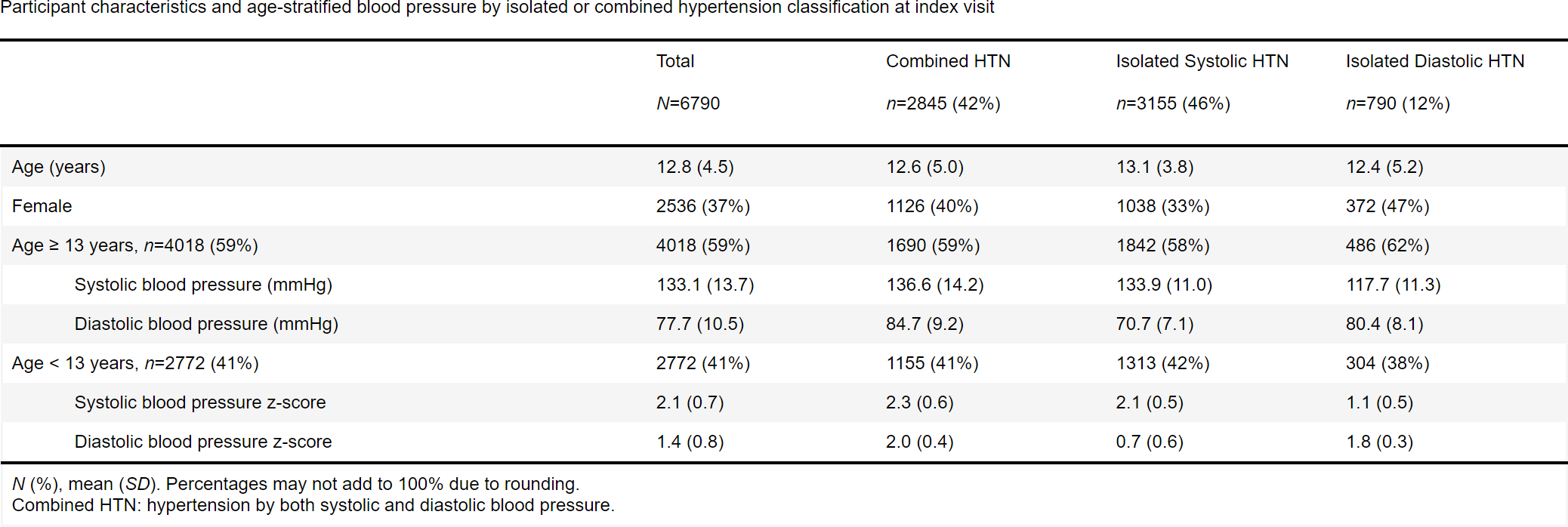Hypertension
Session: Hypertension
74 - Prevalence of Isolated Systolic or Diastolic Hypertension and Association with Hypertension Severity and Cardiovascular Health at Baseline in Youth Referred for Hypertension
Sunday, May 5, 2024
3:30 PM - 6:00 PM ET
Poster Number: 74
Publication Number: 74.1853
Publication Number: 74.1853
- IS
Ileana M. Serrano Herrera, MD (she/her/hers)
Clincal Fellow
Columbia University Vagelos College of Physicians and Surgeons
New York, New York, United States
Presenting Author(s)
Background: Isolated systolic hypertension (ISH) and isolated diastolic hypertension (IDH) are present in 2%-5% of young adults and are associated with increased cardiovascular (CV) disease risk. Data regarding the prevalence of ISH and IDH in the pediatric population is limited, and it is unknown whether ISH and IDH are associated with worse CV health in youth.
Objective: Determine prevalence of ISH and IDH and if they are associated with CV health risk factors in youth referred for hypertension (HTN).
Design/Methods: Cross-sectional analysis of baseline data from the Study of the Epidemiology of Pediatric Hypertension (SUPERHERO), a multisite retrospective registry of youth referred to subspecialty care for HTN using electronic health record data. Inclusion criteria were initial visit for HTN disorder identified by ICD-10 codes from 1/1/2015 to 12/31/2022 and age < 19 years. Exclusion criteria were kidney failure on dialysis, kidney transplantation, or pregnancy by ICD-10 codes. Exposures were ISH or IDH defined by measured systolic or diastolic blood pressure (BP) at the index visit by age, sex, and height-specific guidelines. Outcomes were CV health risk factors: BP severity per national guidelines, obesity as body mass index or weight-for-length ≥95th %ile, target organ injury (TOI), dyslipidemia and hyperglycemia by ICD-10 codes. Adjusted generalized linear models were used.
Results: Of 6790 participants, 37% were female and mean age was 12.8 years (SD 4.5). ISH was present in 46% and IDH was present in 12% of the cohort. Those with IDH (OR 0.15, 95% CL 0.11-0.21) and ISH (OR 0.3, 95% CL 0.27-0.34) had a lower odds of stage 2 HTN compared to combined-type HTN. IDH or ISH were not significantly associated with TOI (Table 2). Those with obesity had lower odds of IDH compared to ISH (OR 0.8, 95% CL 0.68-0.95), however those with dyslipidemia (OR 2.92, 95% CL 2.19-3.91), hyperglycemia (OR 2.42 95% CL 1.87-3.13) and increased number of CV risk factors had higher odds of IDH compared to both combined-type and ISH (Table 2). Obesity (OR 1.4 95% CL 1.26 -1.55), dyslipidemia (OR 1.51 95% CL 1.2 -1.91) and more CV health risk factors (OR 1.27 95% CL 1.18 - 1.36) was associated with higher odds of ISH.
Conclusion(s): In this large cohort of youth with HTN disorders we observed a high prevalence of ISH and IDH. IDH and ISH were associated with lower odds of severe HTN but were not associated with TOI compared to combined-type HTN. Multiple CV health risk factors were associated with both ISH and IDH indicating a role for enhanced screening for comorbidities in those with these BP phenotypes.


.png)
